ISYS316 Assessment 3: Business Process Modelling Report for RFC
VerifiedAdded on 2022/10/31
|13
|3186
|336
Report
AI Summary
This report provides a comprehensive analysis of Reliable Finance Company (RFC), focusing on business process modeling (BPM) and its implications for enterprise architecture (EA). The report examines how EA and BPM are interconnected, and how changes in BPM activities can impact the EA. It discusses the application of value stream mapping for business growth and analyzes the current BPM of RFC, along with recommendations for improvement. The report also explores collaborative business strategies and the role of business intelligence in enhancing RFC's performance. The analysis covers various aspects, including enterprise architecture principles, application of BPM, and the impact of incremental changes on EA blueprints. The report also provides discussions on the importance of information management, application architecture, and technical architecture within the context of RFC's operations and future expansion plans. Furthermore, the report offers insights into collaborative business models, potential barriers, and the role of business intelligence to improve decision-making and strategic planning.
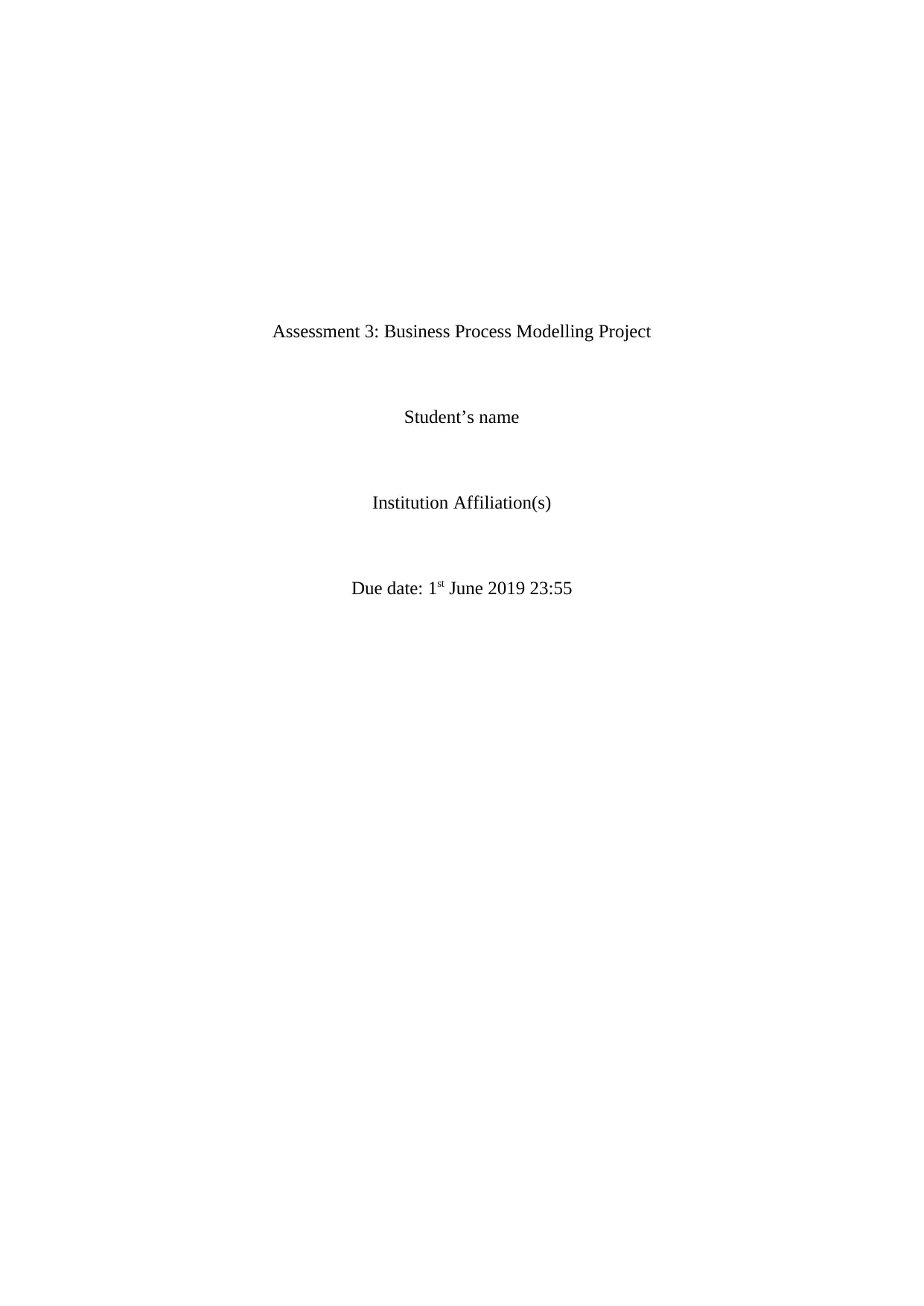
Assessment 3: Business Process Modelling Project
Student’s name
Institution Affiliation(s)
Due date: 1st June 2019 23:55
Student’s name
Institution Affiliation(s)
Due date: 1st June 2019 23:55
Paraphrase This Document
Need a fresh take? Get an instant paraphrase of this document with our AI Paraphraser
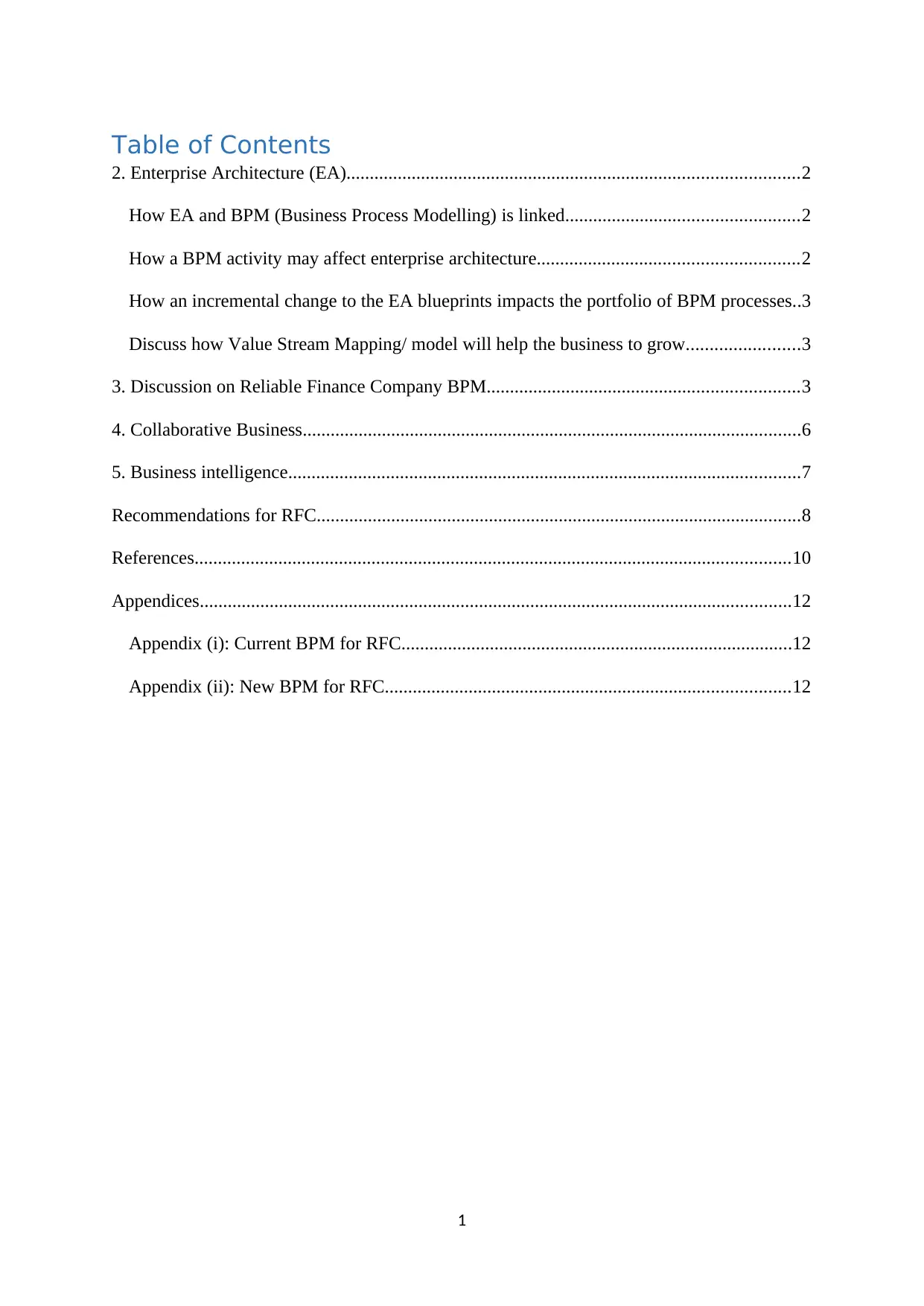
Table of Contents
2. Enterprise Architecture (EA).................................................................................................2
How EA and BPM (Business Process Modelling) is linked..................................................2
How a BPM activity may affect enterprise architecture........................................................2
How an incremental change to the EA blueprints impacts the portfolio of BPM processes..3
Discuss how Value Stream Mapping/ model will help the business to grow........................3
3. Discussion on Reliable Finance Company BPM...................................................................3
4. Collaborative Business...........................................................................................................6
5. Business intelligence..............................................................................................................7
Recommendations for RFC........................................................................................................8
References................................................................................................................................10
Appendices...............................................................................................................................12
Appendix (i): Current BPM for RFC....................................................................................12
Appendix (ii): New BPM for RFC.......................................................................................12
1
2. Enterprise Architecture (EA).................................................................................................2
How EA and BPM (Business Process Modelling) is linked..................................................2
How a BPM activity may affect enterprise architecture........................................................2
How an incremental change to the EA blueprints impacts the portfolio of BPM processes..3
Discuss how Value Stream Mapping/ model will help the business to grow........................3
3. Discussion on Reliable Finance Company BPM...................................................................3
4. Collaborative Business...........................................................................................................6
5. Business intelligence..............................................................................................................7
Recommendations for RFC........................................................................................................8
References................................................................................................................................10
Appendices...............................................................................................................................12
Appendix (i): Current BPM for RFC....................................................................................12
Appendix (ii): New BPM for RFC.......................................................................................12
1
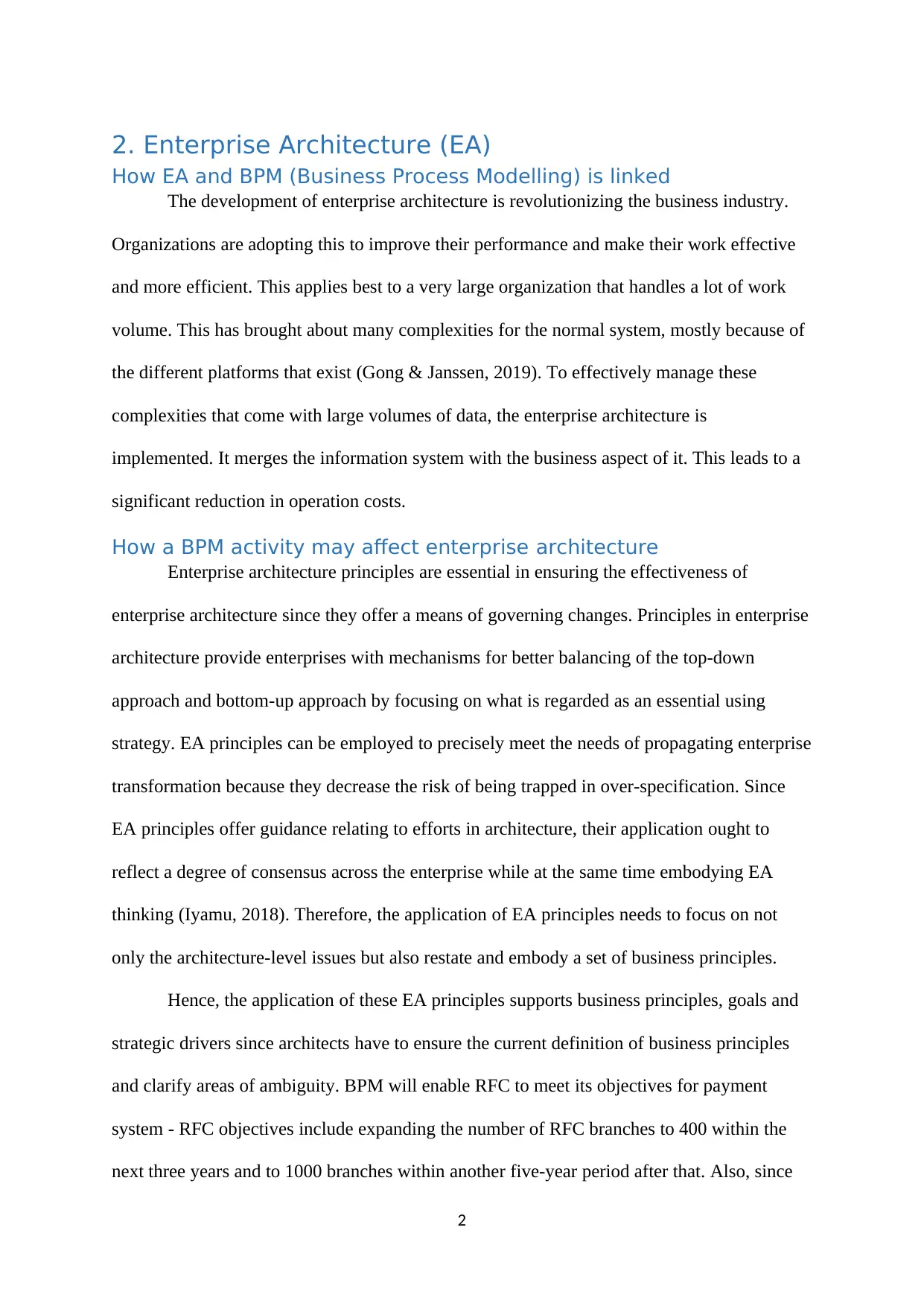
2. Enterprise Architecture (EA)
How EA and BPM (Business Process Modelling) is linked
The development of enterprise architecture is revolutionizing the business industry.
Organizations are adopting this to improve their performance and make their work effective
and more efficient. This applies best to a very large organization that handles a lot of work
volume. This has brought about many complexities for the normal system, mostly because of
the different platforms that exist (Gong & Janssen, 2019). To effectively manage these
complexities that come with large volumes of data, the enterprise architecture is
implemented. It merges the information system with the business aspect of it. This leads to a
significant reduction in operation costs.
How a BPM activity may affect enterprise architecture
Enterprise architecture principles are essential in ensuring the effectiveness of
enterprise architecture since they offer a means of governing changes. Principles in enterprise
architecture provide enterprises with mechanisms for better balancing of the top-down
approach and bottom-up approach by focusing on what is regarded as an essential using
strategy. EA principles can be employed to precisely meet the needs of propagating enterprise
transformation because they decrease the risk of being trapped in over-specification. Since
EA principles offer guidance relating to efforts in architecture, their application ought to
reflect a degree of consensus across the enterprise while at the same time embodying EA
thinking (Iyamu, 2018). Therefore, the application of EA principles needs to focus on not
only the architecture-level issues but also restate and embody a set of business principles.
Hence, the application of these EA principles supports business principles, goals and
strategic drivers since architects have to ensure the current definition of business principles
and clarify areas of ambiguity. BPM will enable RFC to meet its objectives for payment
system - RFC objectives include expanding the number of RFC branches to 400 within the
next three years and to 1000 branches within another five-year period after that. Also, since
2
How EA and BPM (Business Process Modelling) is linked
The development of enterprise architecture is revolutionizing the business industry.
Organizations are adopting this to improve their performance and make their work effective
and more efficient. This applies best to a very large organization that handles a lot of work
volume. This has brought about many complexities for the normal system, mostly because of
the different platforms that exist (Gong & Janssen, 2019). To effectively manage these
complexities that come with large volumes of data, the enterprise architecture is
implemented. It merges the information system with the business aspect of it. This leads to a
significant reduction in operation costs.
How a BPM activity may affect enterprise architecture
Enterprise architecture principles are essential in ensuring the effectiveness of
enterprise architecture since they offer a means of governing changes. Principles in enterprise
architecture provide enterprises with mechanisms for better balancing of the top-down
approach and bottom-up approach by focusing on what is regarded as an essential using
strategy. EA principles can be employed to precisely meet the needs of propagating enterprise
transformation because they decrease the risk of being trapped in over-specification. Since
EA principles offer guidance relating to efforts in architecture, their application ought to
reflect a degree of consensus across the enterprise while at the same time embodying EA
thinking (Iyamu, 2018). Therefore, the application of EA principles needs to focus on not
only the architecture-level issues but also restate and embody a set of business principles.
Hence, the application of these EA principles supports business principles, goals and
strategic drivers since architects have to ensure the current definition of business principles
and clarify areas of ambiguity. BPM will enable RFC to meet its objectives for payment
system - RFC objectives include expanding the number of RFC branches to 400 within the
next three years and to 1000 branches within another five-year period after that. Also, since
2
⊘ This is a preview!⊘
Do you want full access?
Subscribe today to unlock all pages.

Trusted by 1+ million students worldwide
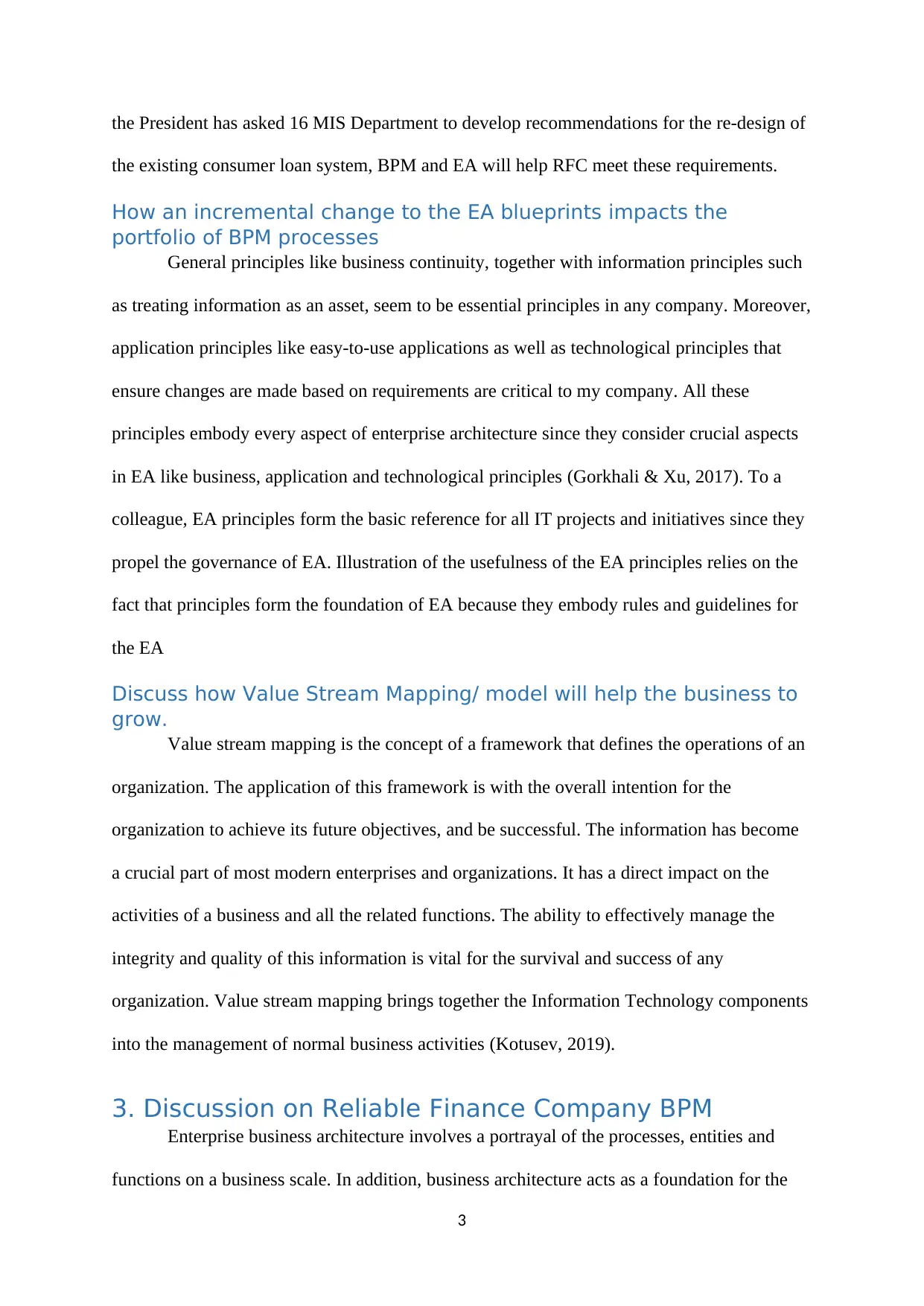
the President has asked 16 MIS Department to develop recommendations for the re-design of
the existing consumer loan system, BPM and EA will help RFC meet these requirements.
How an incremental change to the EA blueprints impacts the
portfolio of BPM processes
General principles like business continuity, together with information principles such
as treating information as an asset, seem to be essential principles in any company. Moreover,
application principles like easy-to-use applications as well as technological principles that
ensure changes are made based on requirements are critical to my company. All these
principles embody every aspect of enterprise architecture since they consider crucial aspects
in EA like business, application and technological principles (Gorkhali & Xu, 2017). To a
colleague, EA principles form the basic reference for all IT projects and initiatives since they
propel the governance of EA. Illustration of the usefulness of the EA principles relies on the
fact that principles form the foundation of EA because they embody rules and guidelines for
the EA
Discuss how Value Stream Mapping/ model will help the business to
grow.
Value stream mapping is the concept of a framework that defines the operations of an
organization. The application of this framework is with the overall intention for the
organization to achieve its future objectives, and be successful. The information has become
a crucial part of most modern enterprises and organizations. It has a direct impact on the
activities of a business and all the related functions. The ability to effectively manage the
integrity and quality of this information is vital for the survival and success of any
organization. Value stream mapping brings together the Information Technology components
into the management of normal business activities (Kotusev, 2019).
3. Discussion on Reliable Finance Company BPM
Enterprise business architecture involves a portrayal of the processes, entities and
functions on a business scale. In addition, business architecture acts as a foundation for the
3
the existing consumer loan system, BPM and EA will help RFC meet these requirements.
How an incremental change to the EA blueprints impacts the
portfolio of BPM processes
General principles like business continuity, together with information principles such
as treating information as an asset, seem to be essential principles in any company. Moreover,
application principles like easy-to-use applications as well as technological principles that
ensure changes are made based on requirements are critical to my company. All these
principles embody every aspect of enterprise architecture since they consider crucial aspects
in EA like business, application and technological principles (Gorkhali & Xu, 2017). To a
colleague, EA principles form the basic reference for all IT projects and initiatives since they
propel the governance of EA. Illustration of the usefulness of the EA principles relies on the
fact that principles form the foundation of EA because they embody rules and guidelines for
the EA
Discuss how Value Stream Mapping/ model will help the business to
grow.
Value stream mapping is the concept of a framework that defines the operations of an
organization. The application of this framework is with the overall intention for the
organization to achieve its future objectives, and be successful. The information has become
a crucial part of most modern enterprises and organizations. It has a direct impact on the
activities of a business and all the related functions. The ability to effectively manage the
integrity and quality of this information is vital for the survival and success of any
organization. Value stream mapping brings together the Information Technology components
into the management of normal business activities (Kotusev, 2019).
3. Discussion on Reliable Finance Company BPM
Enterprise business architecture involves a portrayal of the processes, entities and
functions on a business scale. In addition, business architecture acts as a foundation for the
3
Paraphrase This Document
Need a fresh take? Get an instant paraphrase of this document with our AI Paraphraser
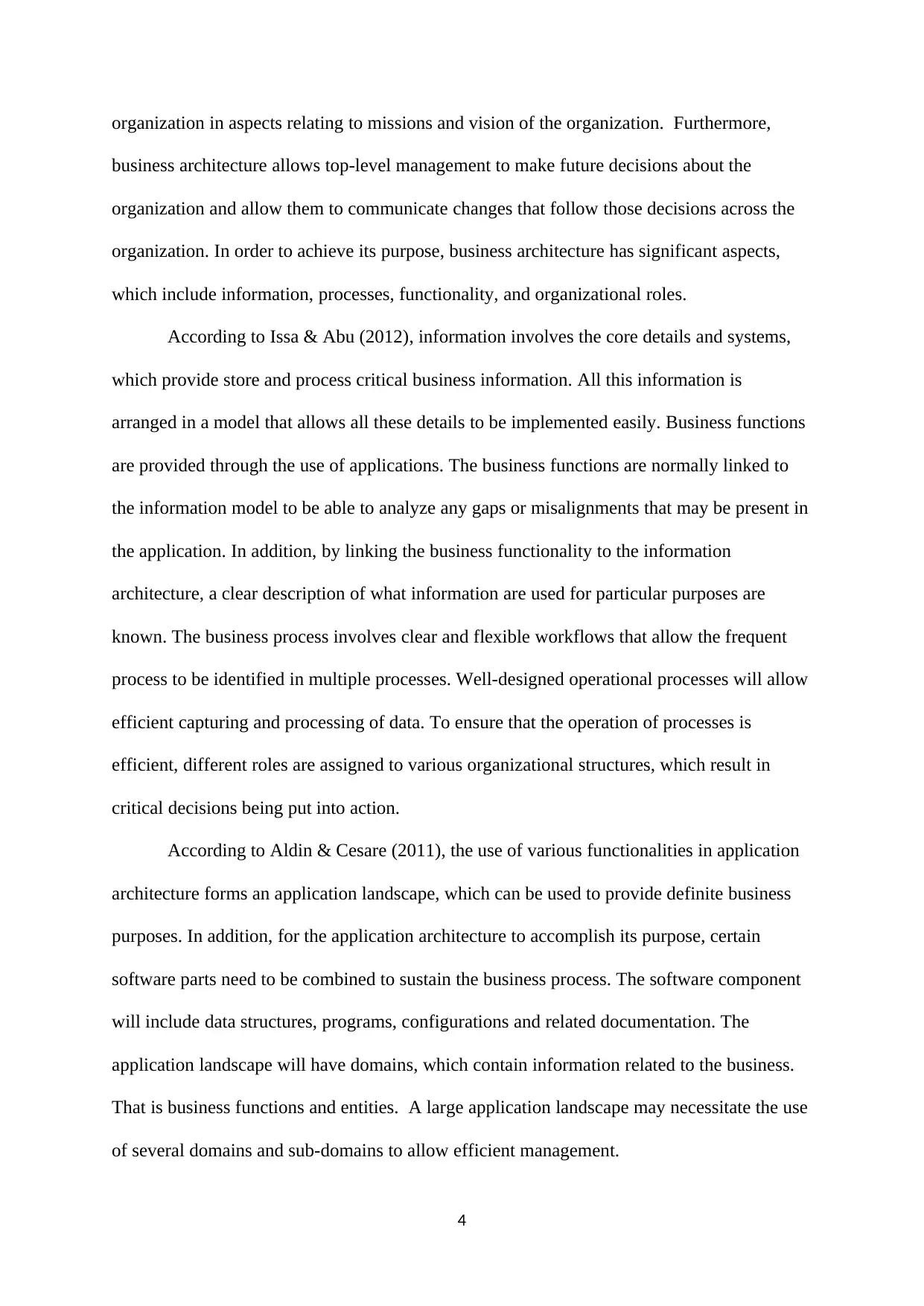
organization in aspects relating to missions and vision of the organization. Furthermore,
business architecture allows top-level management to make future decisions about the
organization and allow them to communicate changes that follow those decisions across the
organization. In order to achieve its purpose, business architecture has significant aspects,
which include information, processes, functionality, and organizational roles.
According to Issa & Abu (2012), information involves the core details and systems,
which provide store and process critical business information. All this information is
arranged in a model that allows all these details to be implemented easily. Business functions
are provided through the use of applications. The business functions are normally linked to
the information model to be able to analyze any gaps or misalignments that may be present in
the application. In addition, by linking the business functionality to the information
architecture, a clear description of what information are used for particular purposes are
known. The business process involves clear and flexible workflows that allow the frequent
process to be identified in multiple processes. Well-designed operational processes will allow
efficient capturing and processing of data. To ensure that the operation of processes is
efficient, different roles are assigned to various organizational structures, which result in
critical decisions being put into action.
According to Aldin & Cesare (2011), the use of various functionalities in application
architecture forms an application landscape, which can be used to provide definite business
purposes. In addition, for the application architecture to accomplish its purpose, certain
software parts need to be combined to sustain the business process. The software component
will include data structures, programs, configurations and related documentation. The
application landscape will have domains, which contain information related to the business.
That is business functions and entities. A large application landscape may necessitate the use
of several domains and sub-domains to allow efficient management.
4
business architecture allows top-level management to make future decisions about the
organization and allow them to communicate changes that follow those decisions across the
organization. In order to achieve its purpose, business architecture has significant aspects,
which include information, processes, functionality, and organizational roles.
According to Issa & Abu (2012), information involves the core details and systems,
which provide store and process critical business information. All this information is
arranged in a model that allows all these details to be implemented easily. Business functions
are provided through the use of applications. The business functions are normally linked to
the information model to be able to analyze any gaps or misalignments that may be present in
the application. In addition, by linking the business functionality to the information
architecture, a clear description of what information are used for particular purposes are
known. The business process involves clear and flexible workflows that allow the frequent
process to be identified in multiple processes. Well-designed operational processes will allow
efficient capturing and processing of data. To ensure that the operation of processes is
efficient, different roles are assigned to various organizational structures, which result in
critical decisions being put into action.
According to Aldin & Cesare (2011), the use of various functionalities in application
architecture forms an application landscape, which can be used to provide definite business
purposes. In addition, for the application architecture to accomplish its purpose, certain
software parts need to be combined to sustain the business process. The software component
will include data structures, programs, configurations and related documentation. The
application landscape will have domains, which contain information related to the business.
That is business functions and entities. A large application landscape may necessitate the use
of several domains and sub-domains to allow efficient management.
4
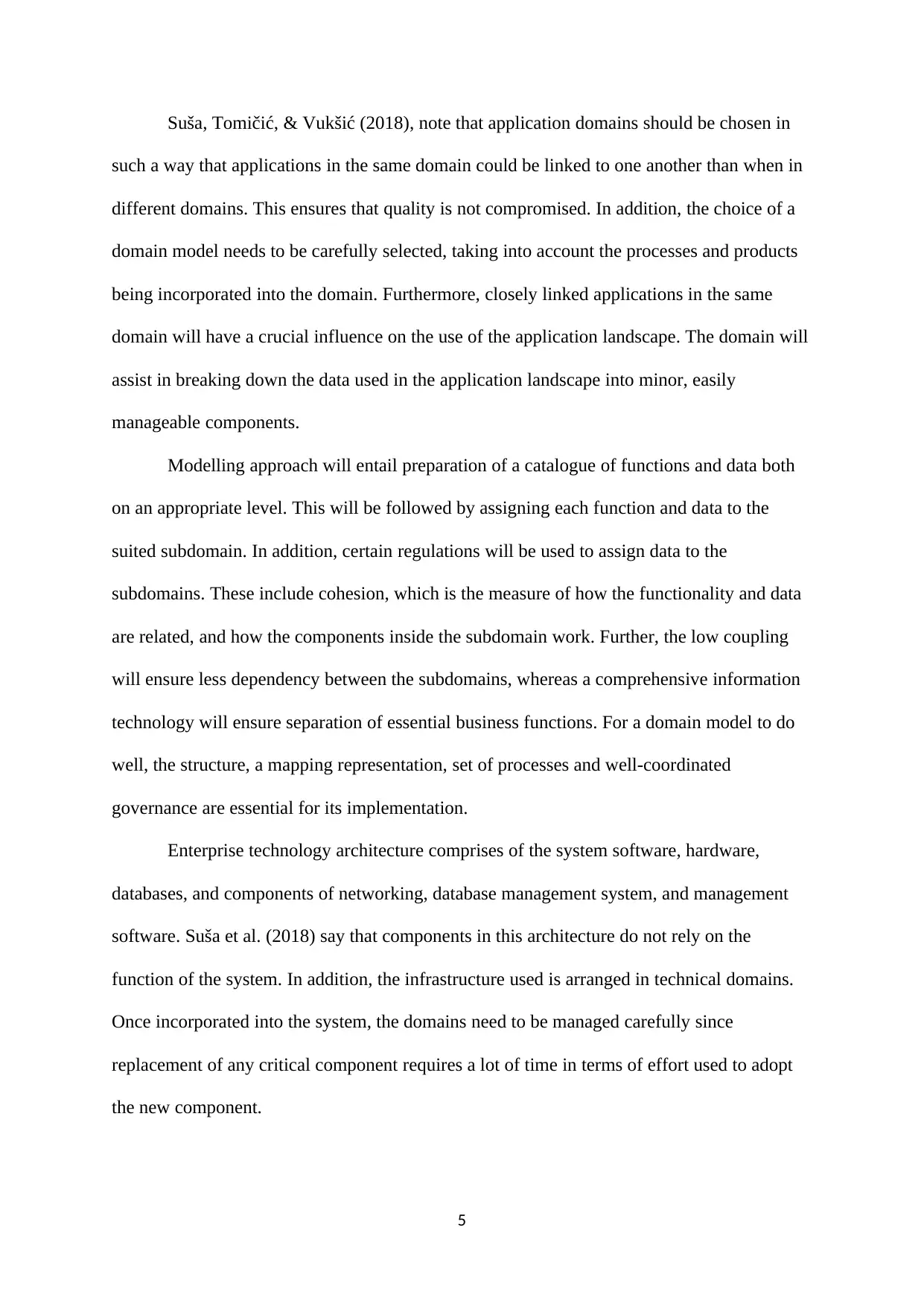
Suša, Tomičić, & Vukšić (2018), note that application domains should be chosen in
such a way that applications in the same domain could be linked to one another than when in
different domains. This ensures that quality is not compromised. In addition, the choice of a
domain model needs to be carefully selected, taking into account the processes and products
being incorporated into the domain. Furthermore, closely linked applications in the same
domain will have a crucial influence on the use of the application landscape. The domain will
assist in breaking down the data used in the application landscape into minor, easily
manageable components.
Modelling approach will entail preparation of a catalogue of functions and data both
on an appropriate level. This will be followed by assigning each function and data to the
suited subdomain. In addition, certain regulations will be used to assign data to the
subdomains. These include cohesion, which is the measure of how the functionality and data
are related, and how the components inside the subdomain work. Further, the low coupling
will ensure less dependency between the subdomains, whereas a comprehensive information
technology will ensure separation of essential business functions. For a domain model to do
well, the structure, a mapping representation, set of processes and well-coordinated
governance are essential for its implementation.
Enterprise technology architecture comprises of the system software, hardware,
databases, and components of networking, database management system, and management
software. Suša et al. (2018) say that components in this architecture do not rely on the
function of the system. In addition, the infrastructure used is arranged in technical domains.
Once incorporated into the system, the domains need to be managed carefully since
replacement of any critical component requires a lot of time in terms of effort used to adopt
the new component.
5
such a way that applications in the same domain could be linked to one another than when in
different domains. This ensures that quality is not compromised. In addition, the choice of a
domain model needs to be carefully selected, taking into account the processes and products
being incorporated into the domain. Furthermore, closely linked applications in the same
domain will have a crucial influence on the use of the application landscape. The domain will
assist in breaking down the data used in the application landscape into minor, easily
manageable components.
Modelling approach will entail preparation of a catalogue of functions and data both
on an appropriate level. This will be followed by assigning each function and data to the
suited subdomain. In addition, certain regulations will be used to assign data to the
subdomains. These include cohesion, which is the measure of how the functionality and data
are related, and how the components inside the subdomain work. Further, the low coupling
will ensure less dependency between the subdomains, whereas a comprehensive information
technology will ensure separation of essential business functions. For a domain model to do
well, the structure, a mapping representation, set of processes and well-coordinated
governance are essential for its implementation.
Enterprise technology architecture comprises of the system software, hardware,
databases, and components of networking, database management system, and management
software. Suša et al. (2018) say that components in this architecture do not rely on the
function of the system. In addition, the infrastructure used is arranged in technical domains.
Once incorporated into the system, the domains need to be managed carefully since
replacement of any critical component requires a lot of time in terms of effort used to adopt
the new component.
5
⊘ This is a preview!⊘
Do you want full access?
Subscribe today to unlock all pages.

Trusted by 1+ million students worldwide
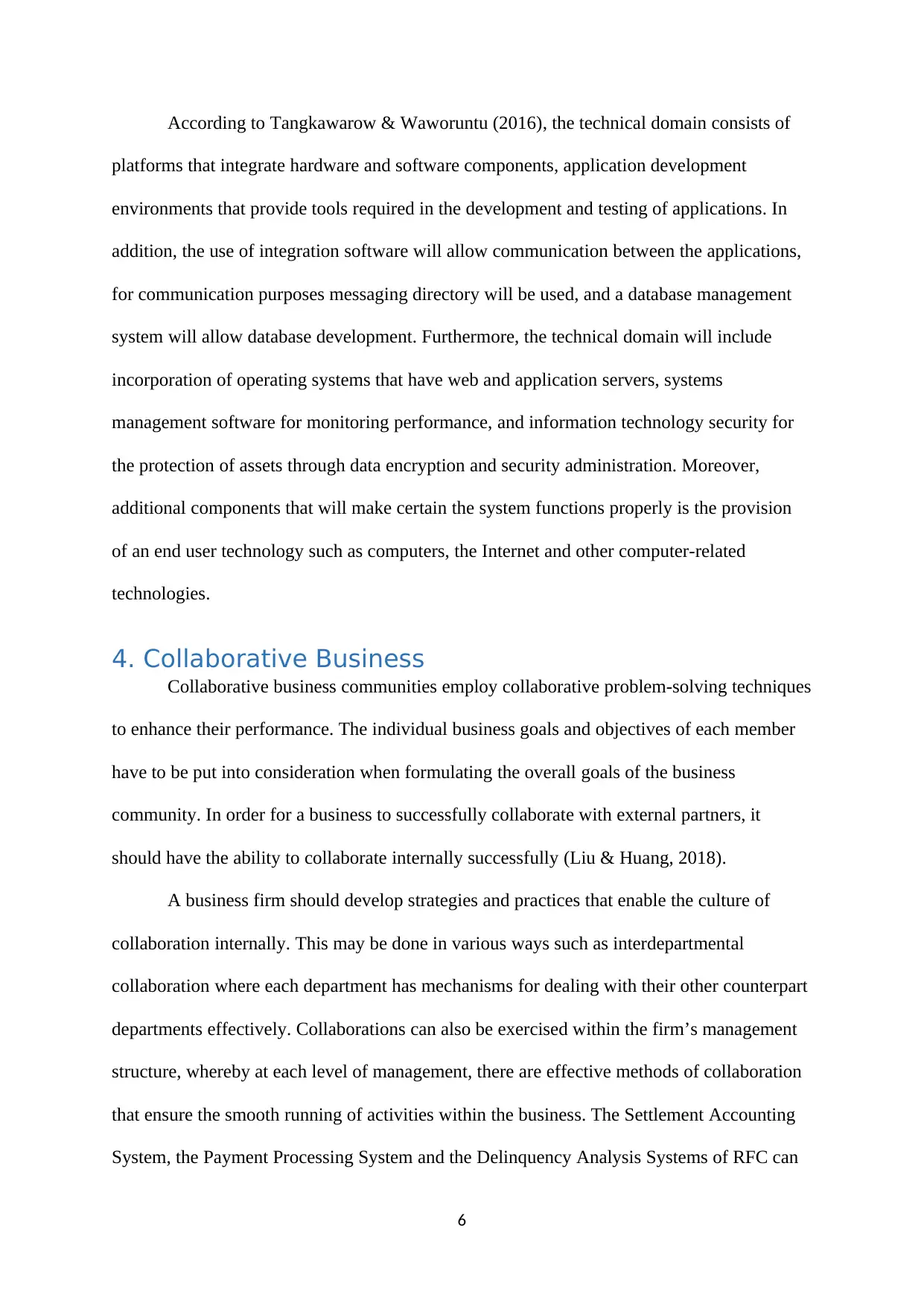
According to Tangkawarow & Waworuntu (2016), the technical domain consists of
platforms that integrate hardware and software components, application development
environments that provide tools required in the development and testing of applications. In
addition, the use of integration software will allow communication between the applications,
for communication purposes messaging directory will be used, and a database management
system will allow database development. Furthermore, the technical domain will include
incorporation of operating systems that have web and application servers, systems
management software for monitoring performance, and information technology security for
the protection of assets through data encryption and security administration. Moreover,
additional components that will make certain the system functions properly is the provision
of an end user technology such as computers, the Internet and other computer-related
technologies.
4. Collaborative Business
Collaborative business communities employ collaborative problem-solving techniques
to enhance their performance. The individual business goals and objectives of each member
have to be put into consideration when formulating the overall goals of the business
community. In order for a business to successfully collaborate with external partners, it
should have the ability to collaborate internally successfully (Liu & Huang, 2018).
A business firm should develop strategies and practices that enable the culture of
collaboration internally. This may be done in various ways such as interdepartmental
collaboration where each department has mechanisms for dealing with their other counterpart
departments effectively. Collaborations can also be exercised within the firm’s management
structure, whereby at each level of management, there are effective methods of collaboration
that ensure the smooth running of activities within the business. The Settlement Accounting
System, the Payment Processing System and the Delinquency Analysis Systems of RFC can
6
platforms that integrate hardware and software components, application development
environments that provide tools required in the development and testing of applications. In
addition, the use of integration software will allow communication between the applications,
for communication purposes messaging directory will be used, and a database management
system will allow database development. Furthermore, the technical domain will include
incorporation of operating systems that have web and application servers, systems
management software for monitoring performance, and information technology security for
the protection of assets through data encryption and security administration. Moreover,
additional components that will make certain the system functions properly is the provision
of an end user technology such as computers, the Internet and other computer-related
technologies.
4. Collaborative Business
Collaborative business communities employ collaborative problem-solving techniques
to enhance their performance. The individual business goals and objectives of each member
have to be put into consideration when formulating the overall goals of the business
community. In order for a business to successfully collaborate with external partners, it
should have the ability to collaborate internally successfully (Liu & Huang, 2018).
A business firm should develop strategies and practices that enable the culture of
collaboration internally. This may be done in various ways such as interdepartmental
collaboration where each department has mechanisms for dealing with their other counterpart
departments effectively. Collaborations can also be exercised within the firm’s management
structure, whereby at each level of management, there are effective methods of collaboration
that ensure the smooth running of activities within the business. The Settlement Accounting
System, the Payment Processing System and the Delinquency Analysis Systems of RFC can
6
Paraphrase This Document
Need a fresh take? Get an instant paraphrase of this document with our AI Paraphraser
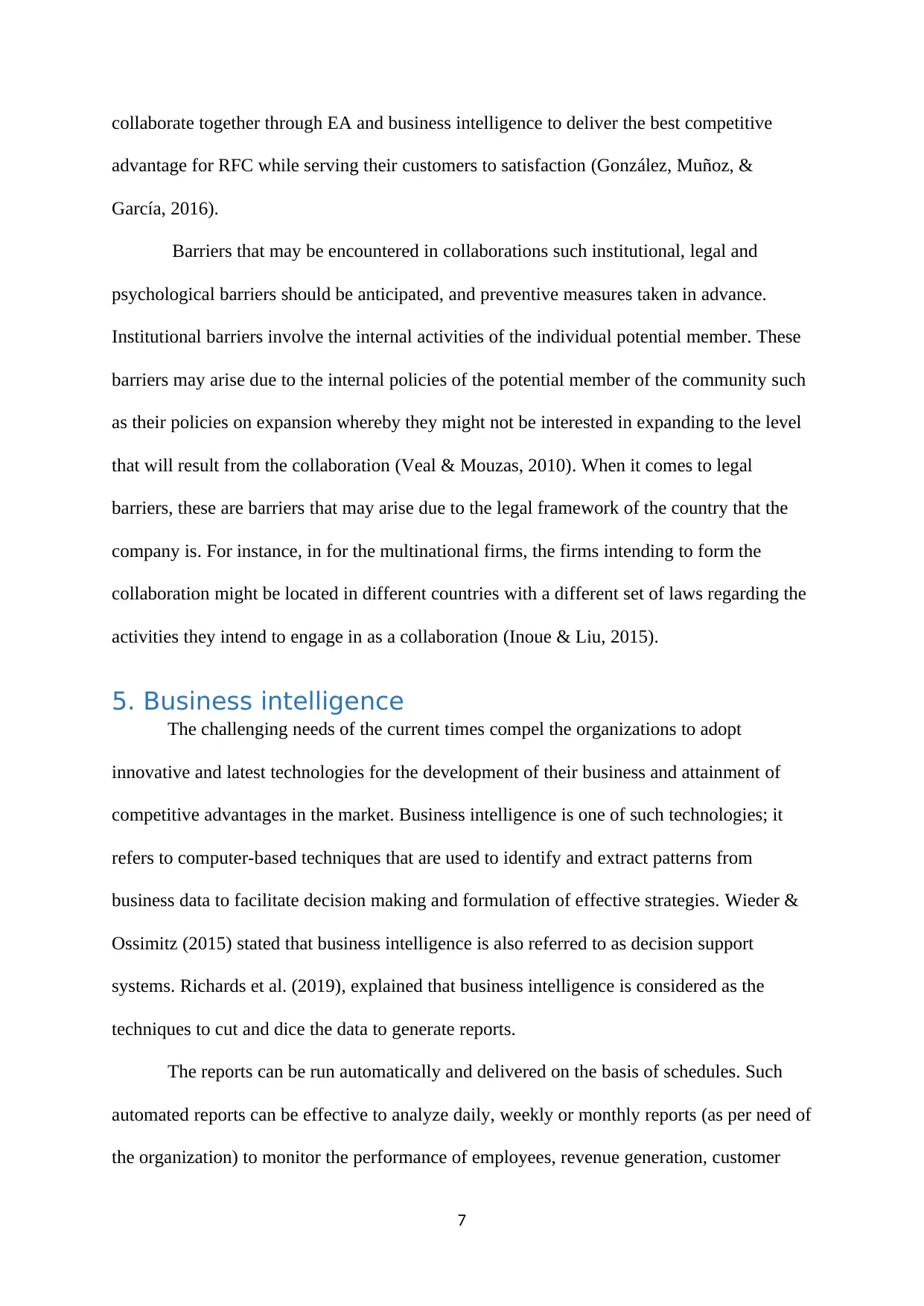
collaborate together through EA and business intelligence to deliver the best competitive
advantage for RFC while serving their customers to satisfaction (González, Muñoz, &
García, 2016).
Barriers that may be encountered in collaborations such institutional, legal and
psychological barriers should be anticipated, and preventive measures taken in advance.
Institutional barriers involve the internal activities of the individual potential member. These
barriers may arise due to the internal policies of the potential member of the community such
as their policies on expansion whereby they might not be interested in expanding to the level
that will result from the collaboration (Veal & Mouzas, 2010). When it comes to legal
barriers, these are barriers that may arise due to the legal framework of the country that the
company is. For instance, in for the multinational firms, the firms intending to form the
collaboration might be located in different countries with a different set of laws regarding the
activities they intend to engage in as a collaboration (Inoue & Liu, 2015).
5. Business intelligence
The challenging needs of the current times compel the organizations to adopt
innovative and latest technologies for the development of their business and attainment of
competitive advantages in the market. Business intelligence is one of such technologies; it
refers to computer-based techniques that are used to identify and extract patterns from
business data to facilitate decision making and formulation of effective strategies. Wieder &
Ossimitz (2015) stated that business intelligence is also referred to as decision support
systems. Richards et al. (2019), explained that business intelligence is considered as the
techniques to cut and dice the data to generate reports.
The reports can be run automatically and delivered on the basis of schedules. Such
automated reports can be effective to analyze daily, weekly or monthly reports (as per need of
the organization) to monitor the performance of employees, revenue generation, customer
7
advantage for RFC while serving their customers to satisfaction (González, Muñoz, &
García, 2016).
Barriers that may be encountered in collaborations such institutional, legal and
psychological barriers should be anticipated, and preventive measures taken in advance.
Institutional barriers involve the internal activities of the individual potential member. These
barriers may arise due to the internal policies of the potential member of the community such
as their policies on expansion whereby they might not be interested in expanding to the level
that will result from the collaboration (Veal & Mouzas, 2010). When it comes to legal
barriers, these are barriers that may arise due to the legal framework of the country that the
company is. For instance, in for the multinational firms, the firms intending to form the
collaboration might be located in different countries with a different set of laws regarding the
activities they intend to engage in as a collaboration (Inoue & Liu, 2015).
5. Business intelligence
The challenging needs of the current times compel the organizations to adopt
innovative and latest technologies for the development of their business and attainment of
competitive advantages in the market. Business intelligence is one of such technologies; it
refers to computer-based techniques that are used to identify and extract patterns from
business data to facilitate decision making and formulation of effective strategies. Wieder &
Ossimitz (2015) stated that business intelligence is also referred to as decision support
systems. Richards et al. (2019), explained that business intelligence is considered as the
techniques to cut and dice the data to generate reports.
The reports can be run automatically and delivered on the basis of schedules. Such
automated reports can be effective to analyze daily, weekly or monthly reports (as per need of
the organization) to monitor the performance of employees, revenue generation, customer
7
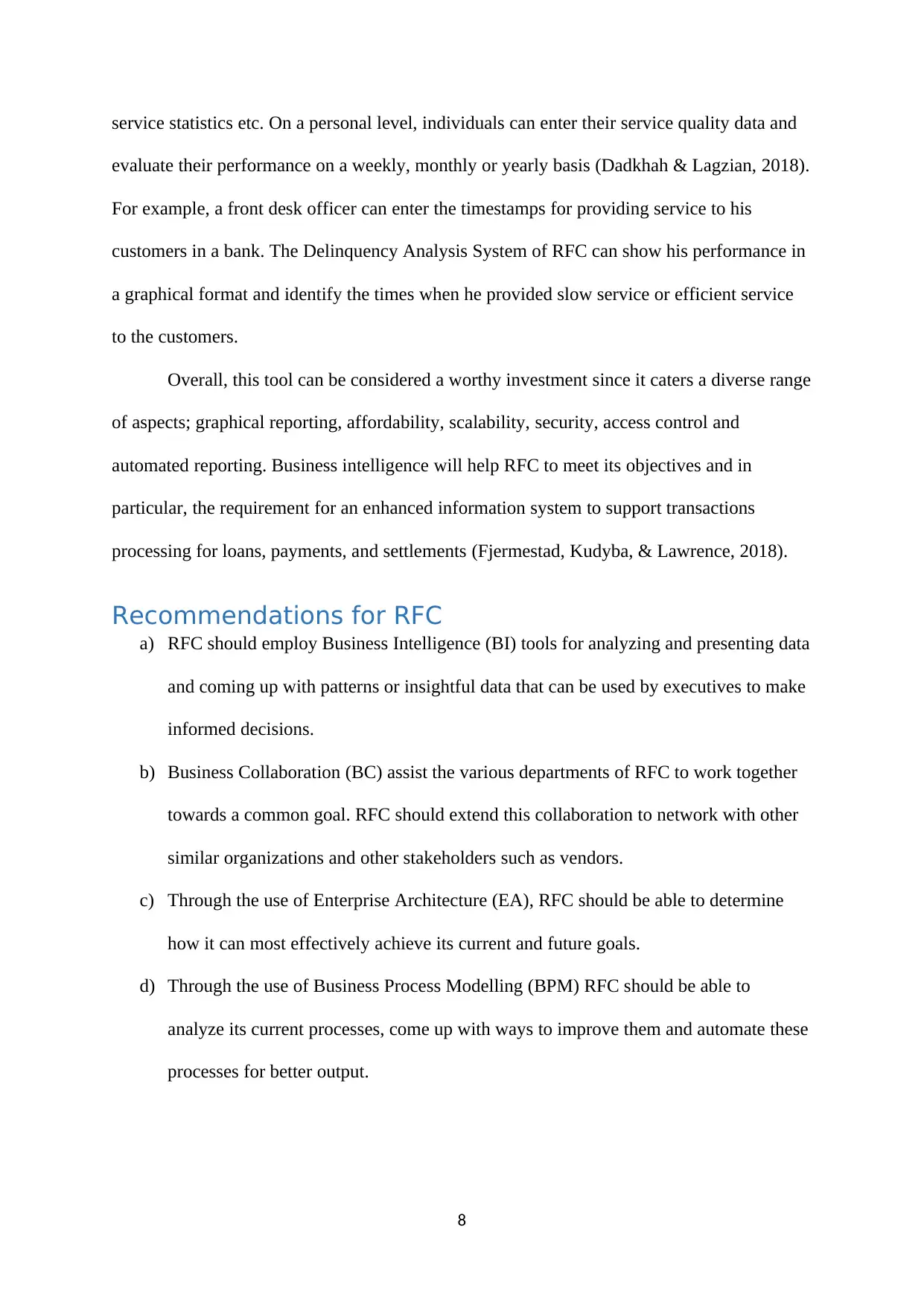
service statistics etc. On a personal level, individuals can enter their service quality data and
evaluate their performance on a weekly, monthly or yearly basis (Dadkhah & Lagzian, 2018).
For example, a front desk officer can enter the timestamps for providing service to his
customers in a bank. The Delinquency Analysis System of RFC can show his performance in
a graphical format and identify the times when he provided slow service or efficient service
to the customers.
Overall, this tool can be considered a worthy investment since it caters a diverse range
of aspects; graphical reporting, affordability, scalability, security, access control and
automated reporting. Business intelligence will help RFC to meet its objectives and in
particular, the requirement for an enhanced information system to support transactions
processing for loans, payments, and settlements (Fjermestad, Kudyba, & Lawrence, 2018).
Recommendations for RFC
a) RFC should employ Business Intelligence (BI) tools for analyzing and presenting data
and coming up with patterns or insightful data that can be used by executives to make
informed decisions.
b) Business Collaboration (BC) assist the various departments of RFC to work together
towards a common goal. RFC should extend this collaboration to network with other
similar organizations and other stakeholders such as vendors.
c) Through the use of Enterprise Architecture (EA), RFC should be able to determine
how it can most effectively achieve its current and future goals.
d) Through the use of Business Process Modelling (BPM) RFC should be able to
analyze its current processes, come up with ways to improve them and automate these
processes for better output.
8
evaluate their performance on a weekly, monthly or yearly basis (Dadkhah & Lagzian, 2018).
For example, a front desk officer can enter the timestamps for providing service to his
customers in a bank. The Delinquency Analysis System of RFC can show his performance in
a graphical format and identify the times when he provided slow service or efficient service
to the customers.
Overall, this tool can be considered a worthy investment since it caters a diverse range
of aspects; graphical reporting, affordability, scalability, security, access control and
automated reporting. Business intelligence will help RFC to meet its objectives and in
particular, the requirement for an enhanced information system to support transactions
processing for loans, payments, and settlements (Fjermestad, Kudyba, & Lawrence, 2018).
Recommendations for RFC
a) RFC should employ Business Intelligence (BI) tools for analyzing and presenting data
and coming up with patterns or insightful data that can be used by executives to make
informed decisions.
b) Business Collaboration (BC) assist the various departments of RFC to work together
towards a common goal. RFC should extend this collaboration to network with other
similar organizations and other stakeholders such as vendors.
c) Through the use of Enterprise Architecture (EA), RFC should be able to determine
how it can most effectively achieve its current and future goals.
d) Through the use of Business Process Modelling (BPM) RFC should be able to
analyze its current processes, come up with ways to improve them and automate these
processes for better output.
8
⊘ This is a preview!⊘
Do you want full access?
Subscribe today to unlock all pages.

Trusted by 1+ million students worldwide

e) RFC should integrate its Information Systems (IS) such that all the departments can
be served by a single information system. These will enable the company to operate
on real-time, reduce errors and improve customer satisfaction.
9
be served by a single information system. These will enable the company to operate
on real-time, reduce errors and improve customer satisfaction.
9
Paraphrase This Document
Need a fresh take? Get an instant paraphrase of this document with our AI Paraphraser
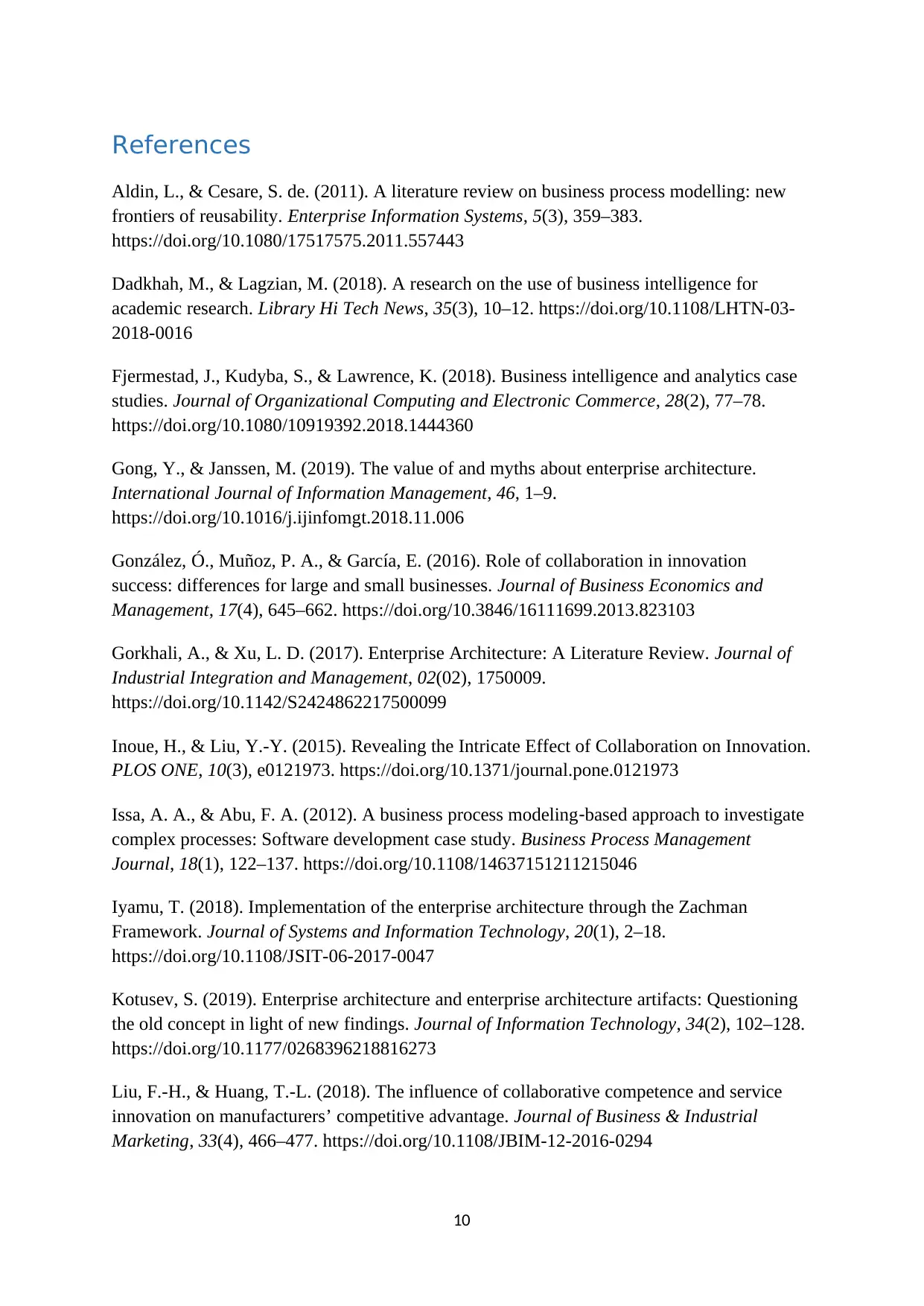
References
Aldin, L., & Cesare, S. de. (2011). A literature review on business process modelling: new
frontiers of reusability. Enterprise Information Systems, 5(3), 359–383.
https://doi.org/10.1080/17517575.2011.557443
Dadkhah, M., & Lagzian, M. (2018). A research on the use of business intelligence for
academic research. Library Hi Tech News, 35(3), 10–12. https://doi.org/10.1108/LHTN-03-
2018-0016
Fjermestad, J., Kudyba, S., & Lawrence, K. (2018). Business intelligence and analytics case
studies. Journal of Organizational Computing and Electronic Commerce, 28(2), 77–78.
https://doi.org/10.1080/10919392.2018.1444360
Gong, Y., & Janssen, M. (2019). The value of and myths about enterprise architecture.
International Journal of Information Management, 46, 1–9.
https://doi.org/10.1016/j.ijinfomgt.2018.11.006
González, Ó., Muñoz, P. A., & García, E. (2016). Role of collaboration in innovation
success: differences for large and small businesses. Journal of Business Economics and
Management, 17(4), 645–662. https://doi.org/10.3846/16111699.2013.823103
Gorkhali, A., & Xu, L. D. (2017). Enterprise Architecture: A Literature Review. Journal of
Industrial Integration and Management, 02(02), 1750009.
https://doi.org/10.1142/S2424862217500099
Inoue, H., & Liu, Y.-Y. (2015). Revealing the Intricate Effect of Collaboration on Innovation.
PLOS ONE, 10(3), e0121973. https://doi.org/10.1371/journal.pone.0121973
Issa, A. A., & Abu, F. A. (2012). A business process modeling‐based approach to investigate
complex processes: Software development case study. Business Process Management
Journal, 18(1), 122–137. https://doi.org/10.1108/14637151211215046
Iyamu, T. (2018). Implementation of the enterprise architecture through the Zachman
Framework. Journal of Systems and Information Technology, 20(1), 2–18.
https://doi.org/10.1108/JSIT-06-2017-0047
Kotusev, S. (2019). Enterprise architecture and enterprise architecture artifacts: Questioning
the old concept in light of new findings. Journal of Information Technology, 34(2), 102–128.
https://doi.org/10.1177/0268396218816273
Liu, F.-H., & Huang, T.-L. (2018). The influence of collaborative competence and service
innovation on manufacturers’ competitive advantage. Journal of Business & Industrial
Marketing, 33(4), 466–477. https://doi.org/10.1108/JBIM-12-2016-0294
10
Aldin, L., & Cesare, S. de. (2011). A literature review on business process modelling: new
frontiers of reusability. Enterprise Information Systems, 5(3), 359–383.
https://doi.org/10.1080/17517575.2011.557443
Dadkhah, M., & Lagzian, M. (2018). A research on the use of business intelligence for
academic research. Library Hi Tech News, 35(3), 10–12. https://doi.org/10.1108/LHTN-03-
2018-0016
Fjermestad, J., Kudyba, S., & Lawrence, K. (2018). Business intelligence and analytics case
studies. Journal of Organizational Computing and Electronic Commerce, 28(2), 77–78.
https://doi.org/10.1080/10919392.2018.1444360
Gong, Y., & Janssen, M. (2019). The value of and myths about enterprise architecture.
International Journal of Information Management, 46, 1–9.
https://doi.org/10.1016/j.ijinfomgt.2018.11.006
González, Ó., Muñoz, P. A., & García, E. (2016). Role of collaboration in innovation
success: differences for large and small businesses. Journal of Business Economics and
Management, 17(4), 645–662. https://doi.org/10.3846/16111699.2013.823103
Gorkhali, A., & Xu, L. D. (2017). Enterprise Architecture: A Literature Review. Journal of
Industrial Integration and Management, 02(02), 1750009.
https://doi.org/10.1142/S2424862217500099
Inoue, H., & Liu, Y.-Y. (2015). Revealing the Intricate Effect of Collaboration on Innovation.
PLOS ONE, 10(3), e0121973. https://doi.org/10.1371/journal.pone.0121973
Issa, A. A., & Abu, F. A. (2012). A business process modeling‐based approach to investigate
complex processes: Software development case study. Business Process Management
Journal, 18(1), 122–137. https://doi.org/10.1108/14637151211215046
Iyamu, T. (2018). Implementation of the enterprise architecture through the Zachman
Framework. Journal of Systems and Information Technology, 20(1), 2–18.
https://doi.org/10.1108/JSIT-06-2017-0047
Kotusev, S. (2019). Enterprise architecture and enterprise architecture artifacts: Questioning
the old concept in light of new findings. Journal of Information Technology, 34(2), 102–128.
https://doi.org/10.1177/0268396218816273
Liu, F.-H., & Huang, T.-L. (2018). The influence of collaborative competence and service
innovation on manufacturers’ competitive advantage. Journal of Business & Industrial
Marketing, 33(4), 466–477. https://doi.org/10.1108/JBIM-12-2016-0294
10
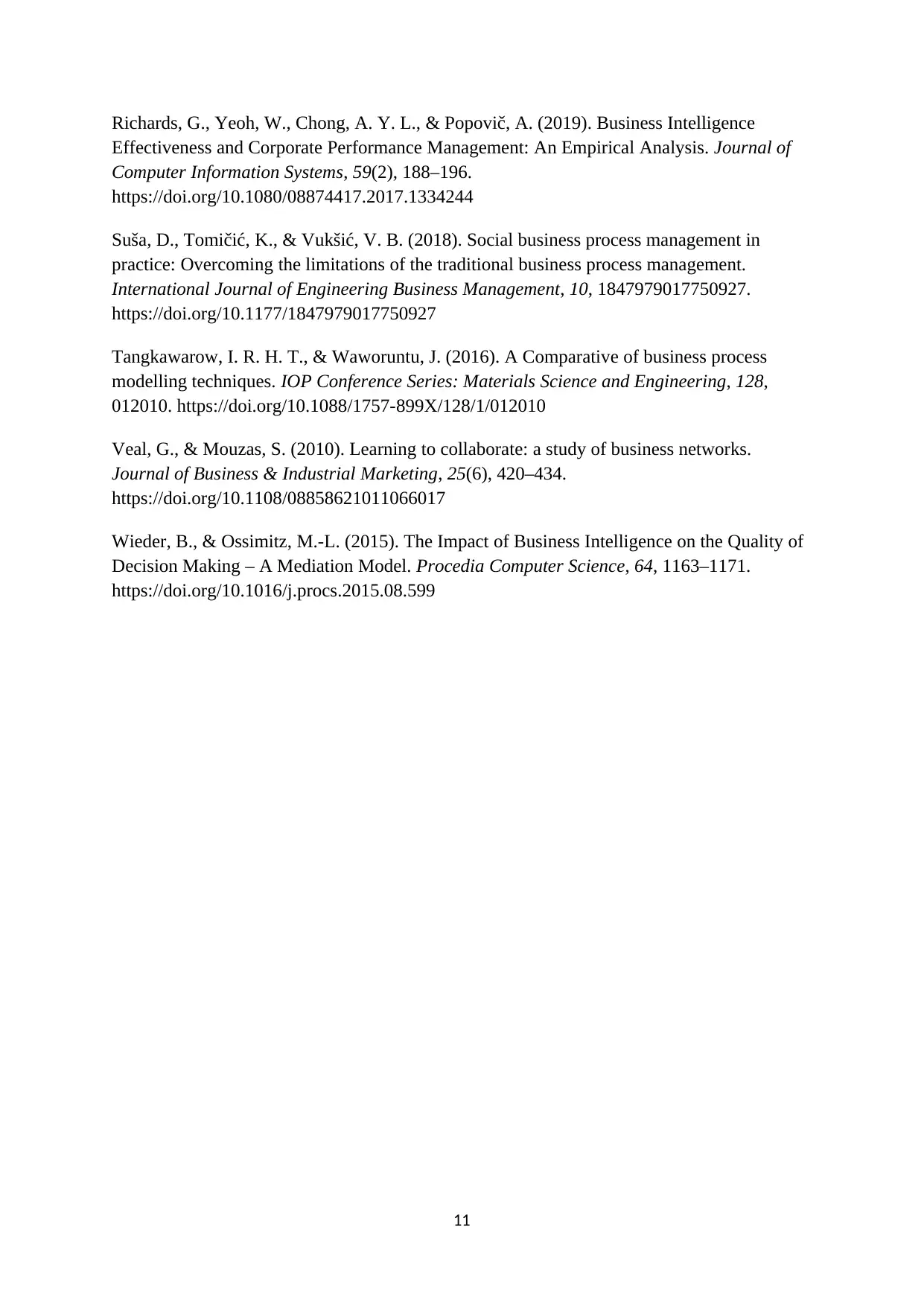
Richards, G., Yeoh, W., Chong, A. Y. L., & Popovič, A. (2019). Business Intelligence
Effectiveness and Corporate Performance Management: An Empirical Analysis. Journal of
Computer Information Systems, 59(2), 188–196.
https://doi.org/10.1080/08874417.2017.1334244
Suša, D., Tomičić, K., & Vukšić, V. B. (2018). Social business process management in
practice: Overcoming the limitations of the traditional business process management.
International Journal of Engineering Business Management, 10, 1847979017750927.
https://doi.org/10.1177/1847979017750927
Tangkawarow, I. R. H. T., & Waworuntu, J. (2016). A Comparative of business process
modelling techniques. IOP Conference Series: Materials Science and Engineering, 128,
012010. https://doi.org/10.1088/1757-899X/128/1/012010
Veal, G., & Mouzas, S. (2010). Learning to collaborate: a study of business networks.
Journal of Business & Industrial Marketing, 25(6), 420–434.
https://doi.org/10.1108/08858621011066017
Wieder, B., & Ossimitz, M.-L. (2015). The Impact of Business Intelligence on the Quality of
Decision Making – A Mediation Model. Procedia Computer Science, 64, 1163–1171.
https://doi.org/10.1016/j.procs.2015.08.599
11
Effectiveness and Corporate Performance Management: An Empirical Analysis. Journal of
Computer Information Systems, 59(2), 188–196.
https://doi.org/10.1080/08874417.2017.1334244
Suša, D., Tomičić, K., & Vukšić, V. B. (2018). Social business process management in
practice: Overcoming the limitations of the traditional business process management.
International Journal of Engineering Business Management, 10, 1847979017750927.
https://doi.org/10.1177/1847979017750927
Tangkawarow, I. R. H. T., & Waworuntu, J. (2016). A Comparative of business process
modelling techniques. IOP Conference Series: Materials Science and Engineering, 128,
012010. https://doi.org/10.1088/1757-899X/128/1/012010
Veal, G., & Mouzas, S. (2010). Learning to collaborate: a study of business networks.
Journal of Business & Industrial Marketing, 25(6), 420–434.
https://doi.org/10.1108/08858621011066017
Wieder, B., & Ossimitz, M.-L. (2015). The Impact of Business Intelligence on the Quality of
Decision Making – A Mediation Model. Procedia Computer Science, 64, 1163–1171.
https://doi.org/10.1016/j.procs.2015.08.599
11
⊘ This is a preview!⊘
Do you want full access?
Subscribe today to unlock all pages.

Trusted by 1+ million students worldwide
1 out of 13
Related Documents
Your All-in-One AI-Powered Toolkit for Academic Success.
+13062052269
info@desklib.com
Available 24*7 on WhatsApp / Email
![[object Object]](/_next/static/media/star-bottom.7253800d.svg)
Unlock your academic potential
Copyright © 2020–2025 A2Z Services. All Rights Reserved. Developed and managed by ZUCOL.





